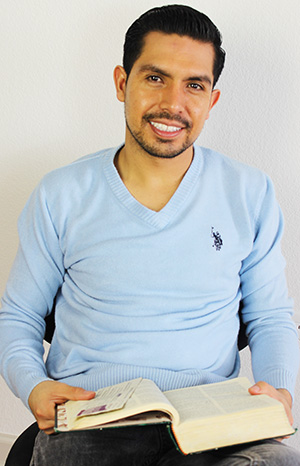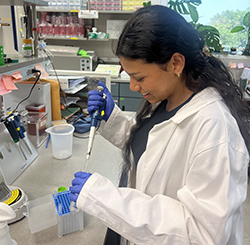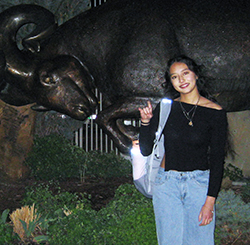
Ramirez-Gordillo Lab
Neurosurgery Research
We are studying the role of local and long-range interneurons in an olfactory learning behavior involving processing of the incoming signal in the prefrontal cortex and learning in hippocampus and interactions of these two brain regions. Studies in hippocampus suggest that information is transferred between brain areas by “chunks” of neuronal activity firing at gamma frequency that take place at specific phases of the slower theta frequency oscillations (PAC) (12, 13). In our lab we showed that the accuracy for encoding the identity of the rewarded odorant in a go-no go odor discrimination task from olfactory bulb CFC oscillatory activity was higher when the decoder evaluated the power (amplitude) of gamma oscillations (65-95 Hz) at the peak phase of the slower theta oscillation (6-14 Hz). In addition, the accuracy of decoding increased as the animal learned to discriminate odorants (14). Furthermore, my preliminary data (15) shows that the coherence of theta oscillations between the prefrontal cortex and CA1 is smaller in CaMKIIα KO mice compared to wild type mice undergoing this go-no go task.
Dr. Daniel Ramirez- Gordillo is an assistant professor at the University of Colorado Anschutz Medical Campus. He earned his PhD in biology/neurobiology from New Mexico State University. His research interest is in diseases and disorders that affect the
central nervous system. He is currently working on two projects that aim to understand the circuitry between the prefrontal cortex and hippocampus. One project aims to understand the role of CaMKIIα in learning and memory formation. Specifically,
how decreased expression of CaMKIIα affects phase amplitude coupling, theta reference power and coherence. The second project aims to study the function of long-range interneurons in regulating neuronal oscillations and how activation of long-range
interneurons affects learning and memory. He enjoys talking and educating elementary, middle, and high school students about careers in science.

"I was born in Greeley, Colorado, and raised in the Aurora/Metro area. Previous to accepting a position in the Neurosurgery Department, I worked in the animal vivarium as an animal care technician, where I gained a ton of knowledge about animal husbandry. Working with OLAR, I was privileged to work with various species including mice, rats, pigs, cats, chinchillas, and many different animals. After seven years of working with animals, I decided it was time to take on a different challenge and moved on to a leadership position in the Cage Wash Department in OLAR which helped me gain immense respect for what happens in the background of animal research. In my free time, I enjoy fishing, camping, and overall, just being outdoors."
(1/4)
(2/4)
(3/4)
(4/4)
 Adrienne Chiapuzio
Adrienne Chiapuzio
I’m a summer intern in Dr. Ramirez-Gordillo’s lab. I’m wrapping up my undergraduate education at Colorado Mesa University where I’m majoring in Exercise Science with a minor in Biology. While my education has mostly circled around the importance of exercise and movement to maintain physical independence throughout life, my interests lie heavily on how to use exercise to ameliorate brain and cognitive health through both normal aging processes as well as diseased states. Spending the summer in the lab will allow me to explore further education or career options, as well as get hands on experience researching topics that are important to me, and that I can connect to my education thus far. Outside of school, I enjoy spending time hiking and taking advantage of the beautiful Colorado landscape with my daughter.

Lizeth Hernandez
My name is Lizeth Hernandez, and I am currently an undergraduate student at Metropolitan State University of Denver, where I am pursuing a degree in Biology with a minor in Chemistry. Dr. Danie Ramirez-Gordillo is my advisor. He is advising me in career choices and helping me to identify potential This summer, I had the incredible opportunity to participate in a Research Experiences for Undergraduates (REU) program at Colorado State University. Under the mentorship of Tom Santangelo, I engaged in research focusing on the DNA repair pathways in Archaeal organisms, which are microorganisms that thrive in extreme environments. Specifically, I investigated a putative nucleotide excision repair (NER) pathway in the archaeon Thermococcus kodakarensis (Tko). The nucleotide excision repair (NER) pathway is essential for repairing bulky DNA lesions, playing a vital role in maintaining the genomic integrity of most organisms. Investigating whether the NER pathway exists in Tko could provide valuable insights into the evolutionary conservation of DNA repair mechanisms in archaeal organisms.

Nicole Pineda Gomez
My name Nicole Pineda Gomez and I had the pleasure of being a summer intern in Dr. Daniel Ramirez-Gordillo’s lab. I am currently a second year undergraduate student at Colorado State University majoring in Cognitive and Behavioral Neuroscience. This was my first time being able to work in a laboratory and was able to learn many new things. We looked at Alzheimer’s in 5XFAD mice and using a closed loop optogentic method, we were able to activate PV interneurons. Throughout the experience, Dr. Ramirez-Gordillo was always very patient and there to explain and walk me through any step/ process. In being able to live this experience, I was reminded why I am pursuing my career in the neuroscience field. Whenever I had questions, they were answered. I am also a first generation pre-med student and to be able to receive advice and mentorship from him was truly a privilege.

Angela Ortiz
My name is Angela Ortiz, and I am a first-generation Mexican American undergraduate at Colorado College, majoring in Molecular Biology with a minor in Biochemistry on the Pre-Health track. This summer, I had the privilege of working with Dr. Daniel Ramirez-Gordillo through the CORE program at CU Anschutz. During this experience, I conducted laboratory research investigating how the expression of CaMKII alpha influences learning in the olfactory bulb and hippocampus, using wild-type, heterozygous, and complete CaMKII alpha knockout, as well as Alzheimer’s (5XFAD), mice Dr. Ramirez-Gordillo provided invaluable mentorship, allowing me to gain hands-on experience and strengthen my skills in immunohistochemistry, imaging, minor surgeries, and laboratory techniques. This opportunity deepened my interest in neuroscience research and reinforced my commitment to pursuing a career in science. It also reminded me of the importance of acquiring broad scientific knowledge to help create a healthcare system where everyone feels heard and cared for. I am excited to continue my journey in science and aspire to become a cardiologist.